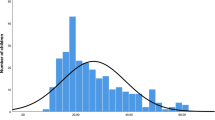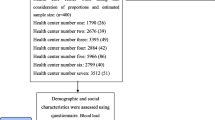Abstract
A survey was performed to know blood lead level (BLL) of children under seven and the risk factors of high BLL in Chengdu, China in 2004. The mean BLL in children under seven in Chengdu was 63.88 μg/L. The detection rate of high BLL was 8.21%. Chengdu is a moderate popular region of lead poisoning. Substitute of breast milk, living at the base floor or in one-storey houses and houses near the streets are the risk factors of high BLL (p < 0.05). The risk of anorexia, spasm and impaired concentration is higher in children whose BLL is higher than those whose BLL is lower (p < 0.05). Living circumstances, feeding patterns, and eating habits affect BLL, which in turn influences children’s health status.
Similar content being viewed by others
References
Alliance to End Childhood Lead Poisoning and Environmental Defense Fund (1994) The global dimensions of lead poisoning: an initial analysis. Alliance to End Childhood Lead Poisoning and Environmental Defense Fund, Washington
Bloch AB, Rosenblum LR, Guthrie AM (2000) Recommendations for blood lead screening of young children enrolled in medicaid: targeting a group at high risk (Advisory Committee on Children Lead Poisoning Prevention, ACCLPP). MMWR Recomm Rep 49:1–13
Canfeld RL, Henderson CR Jr, Cory-Slechta DA, Cox C, Jusko TA, Lanphear BP (2003) Intellectual impairment in children with blood lead concentrations below 10 microg per deciliter. N Engl J Med 348:1517–1526
Flegal AR, Smith DR (1992) Lead levels in preindustrial humans. N Engl J Med 326:1293–1294
International Programme on Chemical Safety (IPCS) (1995) Inorganic lead. Environmental health criteria 165. WHO, Geneva
Mendelsohn AL, Dreyer BP, Fierman AH, Rosen CM, Legano LA, Kruger HA, Lim SW, Barasch S, Au L, Courtlandt CD (1999) Low-level lead exposure and cognitive development in early childhood. J Dev Behav Pediatr 20:425–431
Romieu I, Lacasana M, McConnell R, the Lead Research Group of the Pan-American Health Organization (1997) Lead exposure in Latin America and the Caribbean. Environ Health Perspect 105:398–405
US Centers for Disease Control (1991) Preventing lead poisoning in young children. US Centers for Disease Control, Atlanta
Author information
Authors and Affiliations
Corresponding author
Rights and permissions
About this article
Cite this article
Jiang, Ym., Shi, H., Li, Jy. et al. Environmental Lead Exposure Among Children in Chengdu, China: Blood Lead Levels and Major Sources. Bull Environ Contam Toxicol 84, 1–4 (2010). https://doi.org/10.1007/s00128-009-9876-4
Received:
Accepted:
Published:
Issue Date:
DOI: https://doi.org/10.1007/s00128-009-9876-4




